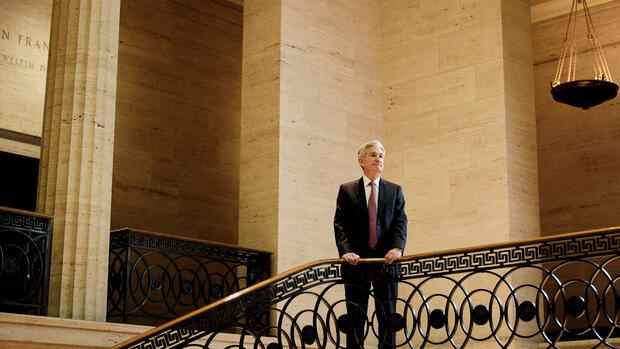Apparently, many investors are assuming that he could be more relaxed about the development of inflation.
(Photo: TJ Kirkpatrick/Redux/laif)
Frankfurt The US Federal Reserve (Fed) has a problem: It wants to tighten monetary policy, but the markets are not playing along. What happened?
Apparently, since August 10 at the latest, many investors have been assuming that Fed Chair Jerome Powell could take a more relaxed view of developments. Because exactly on this day the July value of the US inflation was announced.
At 8.5 percent, it was well below the 9.1 percent of the previous month. This confirmed what many economists had predicted. The price increase had peaked in June and may now gradually recede.
But there is a serious obstacle. Prices are only likely to come under control if the Fed maintains its tight monetary policy course. If, on the other hand, bond yields fall again due to the renewed optimism in the capital markets and stocks rise again, these general conditions will not mean tighter but easier financing conditions for the US economy.
Top jobs of the day
Find the best jobs now and
be notified by email.
This would be the opposite of a tighter monetary policy. So it is no wonder that the Fed is trying to counteract the undesirable scenario.
“I really don’t see any reason to delay rate hikes further into next year,” he says.
(Photo: Reuters)
Most recently, James Bullard, head of the St. Louis regional Fed, spoke to the Wall Street Journal for the September 20-21 Fed meeting and advocated a relatively large rate hike of three-quarters of a percentage point (75 basis points). .
That would be the third increase of this magnitude in a row. “I really don’t see any reason to delay rate hikes further into next year,” he says. In his opinion, the Fed must raise interest rates within a range of 3.75 to 4.0 percent if it wants to fulfill its mandate and bring inflation back to 2 percent.
The key interest rate is currently between 2.25 and 2.5 percent; it was last raised by 75 basis points in July. At the same time, the Fed has already begun to shrink its balance sheet, which peaked at nearly $9 trillion.
Bullard plays a key role on the Fed’s monetary policy committee (FOMC). He used to be considered a dove at times, i.e. a supporter of a soft monetary policy. Still, he was one of the first to push for a tighter monetary policy stance over the past year.
And he was not alone in this view. Other well-known economists such as Larry Summers and Mohamed El-Erian also accused Fed Chair Jerome Powell of reacting too late to the rise in inflation in 2021. This opinion is now widespread.
Lower inflation without triggering a recession?
For example, last Thursday, shortly before Bullard’s statements, Mary Daly also spoke. The head of the San Francisco Fed told CNN that a hike of 50 or 75 basis points was “reasonable”. This means that the key interest rate could be just over three percent by the end of the year and then slightly higher in 2023. Both Bullard and Daly also made it clear that, in their view, the rate hikes should not lead to another rate hike any time soon.
Some of the market data had indicated the expectation that the central bank would trigger a recession with its rapid rate hike and thus be forced to reverse immediately.
Minneapolis Fed Chairman Neel Kashkari recently addressed this issue. “The question now is whether we can bring inflation down without triggering a recession,” he said of the upcoming challenge to the Reuters news agency. And added: “My answer to this question is: I don’t know.”
Fed does not provide a clear trend
Next Friday, Jerome Powell himself will give the opening speech at the traditional central bank meeting in Jackson Hole, Wyoming. Economists and investors will be paying particular attention to his words this year. Because the Fed is currently playing the leading role in the markets again, but is not setting a clear trend.
Prices and yields depend on inflation, central bank signals and recession concerns. When inflation is high, the expectation of a strong monetary policy response increases, which in turn increases interest rates and bond yields, while bond and stock prices fall. The yields thus anticipate the interest rate hike by the Fed.
On the other hand, a strong reaction from the central bank increases the risk of a recession. This tends to lead to lower yields and higher bond prices, especially since government bonds are in demand as a crisis hedge. But a weak economy means slim corporate profits. So this scenario is bad for stock prices.
If, on the other hand, investors expect a more relaxed monetary policy, share and bond prices rise. But exactly this expectation does not suit the Fed at all – that’s why it counters it.
More: Wealth building despite the crisis
